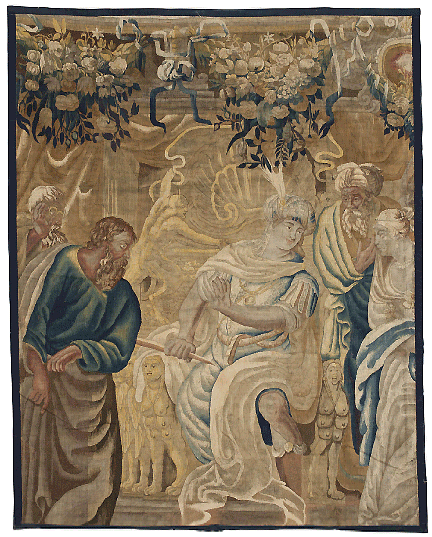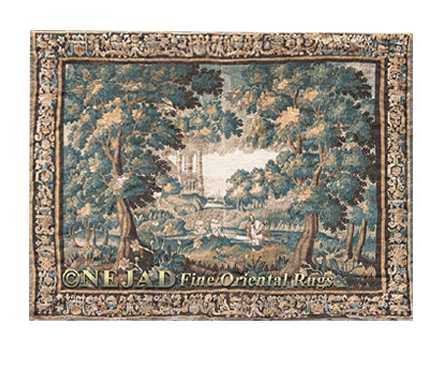
Flemish-17th Century
Garden VerdureTapestry
About Antique Flemish Tapestry
Introduction
|
The term Tapestry, from the Old French tapisserie, meaning "to cover with heavy fabric," refers to the type of decorative textile art usually displayed as a wall hanging. Tapestry-making is typically a collaborative process whereby a design or template, created by the artist, is rendered in wool or fabric (traditionally woven by hand on a loom) by the craftsman - the finished piece ranging from an interpretive rendition to a literal reproduction of the artist's work. The popular appeal of decorative tapestry is due, other than its aesthetic value, to its portability and relative ease of relocation - as compared to a harder substrate such as a framed painting. Once referred to as nomadic murals, large tapestries could be rolled up and conveniently transported from one residence, or one room, to another. Large tapestries were also draped on the interior walls of palaces, castles or cottages for insulation during winter, as well as for decorative display. |
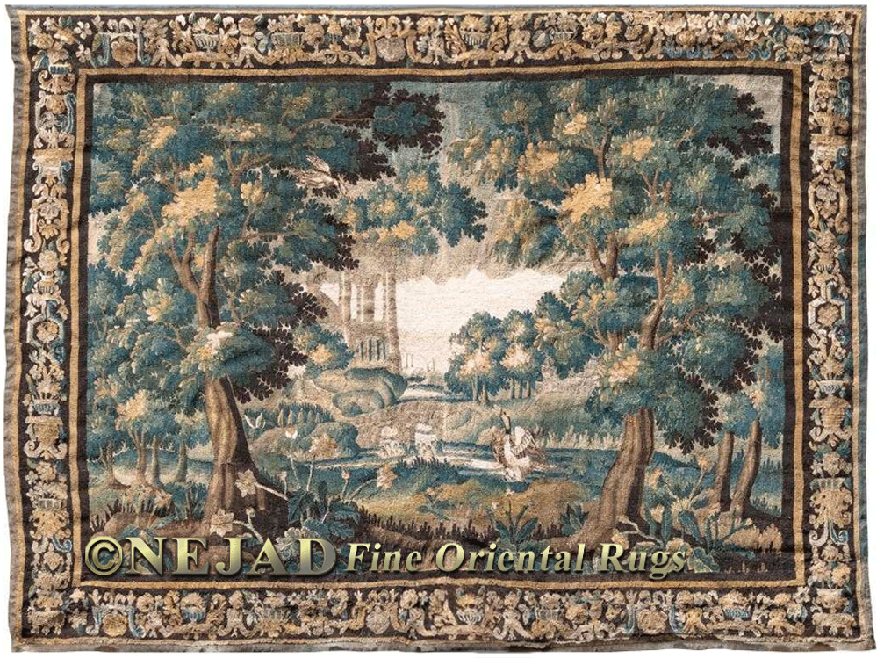
A Flemish 17th Century Verdure Garden Tapestry, in excellent condition with non-faded colors, is now being offered by Nejad.
More detail on this item
Flemish TapestryBy the 16th century the business of the buying and selling of tapestries was conducted, in large part, in France and Flanders and the Flemish towns of Oudenaarde, Brussels, Geraardsbergen and Enghien had become centers of European tapestry making - other limited production centers were Antwerp, Bruges, Grammont, Alost, Lille, and Tournai. For the next hundred years Flemish tapestries were arguably the most important productions of that medium - many intact specimens from this era demonstrating an intricate detail of both pattern and color embodied in painterly compositions, and often of a monumental scale. Flemish weavers were recruited throughout Europe and were invited to Spain, Italy, France, Germany, and where, initially, both the weavers and designers in these countries were Flemings.
Historically, Flanders is notable for its impressive achievements in the decorative arts and architecture - especially with respect to painting and tapestry production. The style of Brussels Renaissance, and later Baroque, tapestry is most typically characterized by the designs of renowned Flemish artists such as Peter Paul Rubens and Bernard van Orley. As one of the leading innovators of 16th-century Flemish tapestry design, van Orley - called "the Raphael of the Netherlands" - is credited with adapting the Italian stylistic attributes of monumentality and sculptural relief to Flemish tastes and tradition. No less influential on the Brussels 17th century tapestry industry were the designs and compositions - featuring mythological and religious themes - of master Antwerp painter Peter Paul Rubens.
By late 15th century, Brussels had acquired a reputation for its production of so-called Golden Carpets (tapis d'or) which referred to the considerable amount of gold thread woven into the tapestry. During this period, not only were tapestries held in higher esteem than paintings, but were usually more expensive, as well. Owing to such factors as papal and imperial (courts of Spain and Austria) patronage, as well as the exemplary skill of its weavers, tapestry making in Brussels became so lucrative during this period that protectionist policies were enacted to protect against forgery.
Verdure TapestryOne of the most distinctive types of tapestry weavings produced in Flanders at this time were the verdures of Enghien and Oudenaarde. Verdure, or garden, tapestry, not to be confused with Millefleur (Thousand Flowers) - a kind of tapestry characterized by a backdrop motif of many small flowers - is a type of tapestry that incorporates design elements based on plant forms and that typically features a scenic garden or countryside landscape setting. In the 16th century, such tapestries with formal designs derived from foliage had become immensely popular, and by the later part of the 17th century, plush wooded landscape scenes were featured with simulated gilded frames (alentours). The French tapestry factories of Aubusson and Lille are also renowned for their production of verdures.
Materials and TechniquesAlthough wool has been the material most widely used for making both the warp (length-running threads) and weft (width-running threads), wool has often been used in combination with linen, cotton or silk threads for the weft. These materials - including metals such as gold or silver - made possible greater variety, detail and contrast of both color and texture. For example, light-coloured silks could be used to create pictorial effects of tonal gradation and the sheen of silk thread was often used for highlights or to give a luminous effect when contrasted to the heavier, darker-colored woolen threads.
The subtle graduations of color and sophisticated designs encountered in the paintings of artists such as Rubens and Boucher posed new problems for the tapestry weaver, now making it necessary for them to learn to "paint" with a bobbin. To this end hundreds of new dyes were developed for both wool and silk, so as to help render more accurately the almost imperceptible tonal modulations in the original painted artwork. Flanders
Consumer NotesTapestry has traditionally been percieved as a luxury art afforded mostly by the wealthy, and the fine wool tapestries produced in thriving textile towns such as Brussels, Belgium and Arras, France were sold to decorate the sumptuous palaces and castles of Europe. In France, few of these tapestries, however, survived the French Revolution as hundreds were burnt to recover the gold thread that was often woven into them. The term Arras is still sometimes used today to refer to a rich tapestry no matter where it was woven. |
About:
Tabriz Antique Rugs | Heriz Antique Rugs | Mashhad Antique Rugs | Sarouk Antique Rugs | Kashan Antique Rugs
Kerman Antique Rugs | Serapi Antique Rugs | Bidjar Antique Rugs | Karabagh Antique Rugs | Kazak Antique Rugs
Turkeman Antique Rugs | Kurdish Antique Rugs | Farahan Antique Rugs | Darjazin-Hamadan Antique Rugs
Hereke Antique Rugs | Akstafa Antique Rugs | Mudjar Antique Rugs | Chichi Antique Rugs | Dagestan Antique Rugs
Senneh Antique Rugs | Shirvan Antique Rugs | Beluch Antique Rugs | Peking Antique Rugs | Qum Antique Rugs
Bakhtiari & Antique Bakhtiari Rugs | Gharajeh (Karaja) Antique Rugs | Ziegler Mahal Antique Persian Rugs
Nain and Antique Nain Persian Rugs | Ming Chinese Rugs | Esfahan and Antique Esfahan
Rugs
Antique Flemish Tapestry | French
Aubusson Antique Tapestry after Francois Boucher
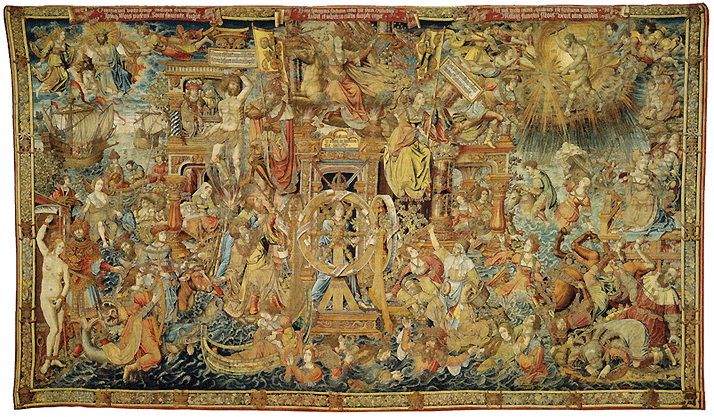
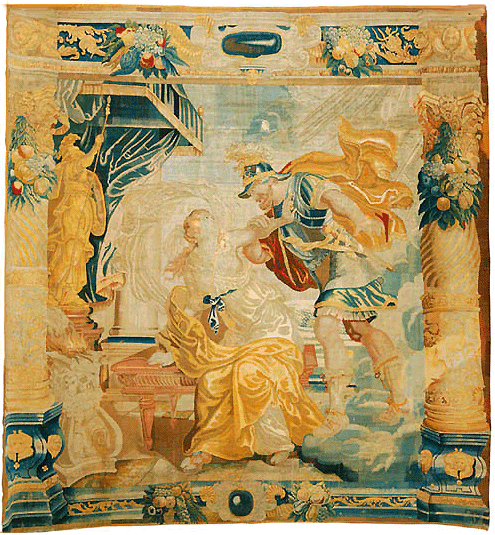
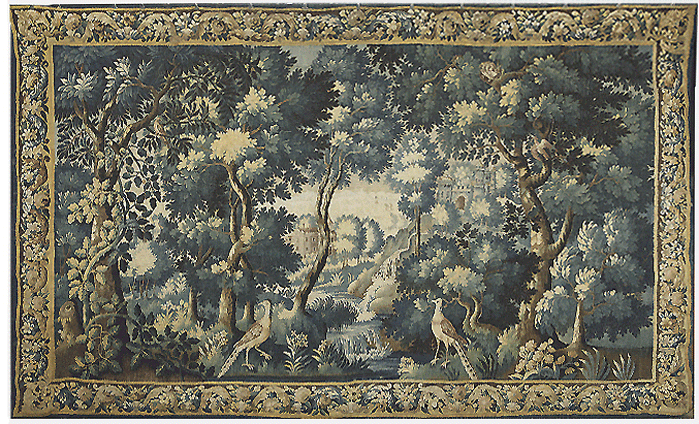
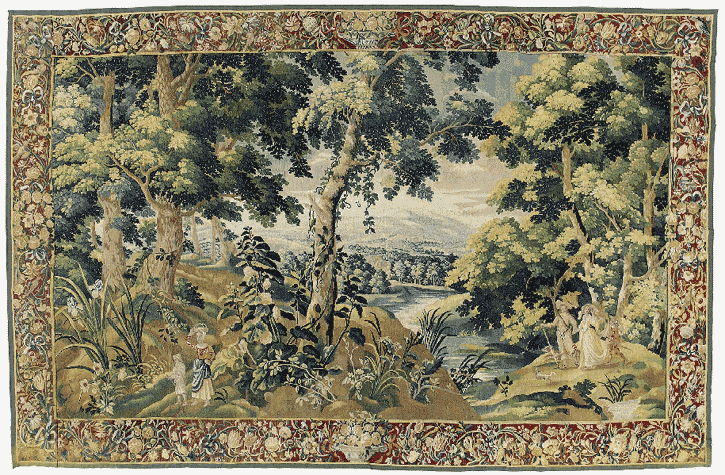
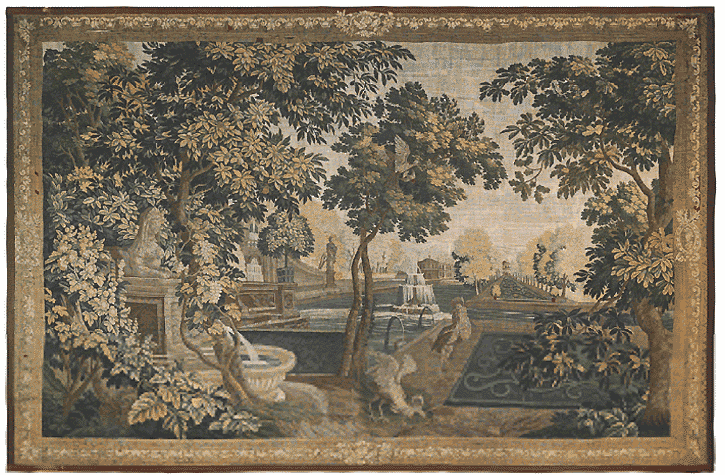
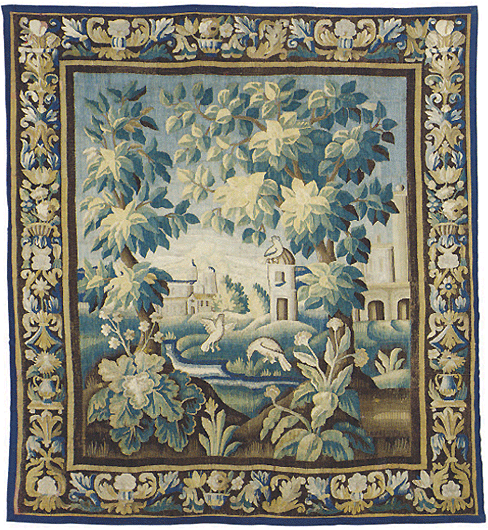
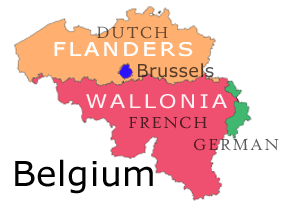 The Flemish
Region of Belgium, Flanders, occupies the entirety of the northern half of the country and
is one of Belgium's three distinct political-linguistic regions - including Wallonia and the
capital city Brussels.
Since the Middle Ages, Flanders has figured prominently in European history and
cities such as Ghent, Bruges, and later Antwerp made it one of the richest and most urbanized
parts of Europe. From trading, and weaving (including tapestry), the wool of neighbouring areas
into cloth for both domestic use and export, the economy modernised rapidly - subsequently
developing into one of the centers of the industrial revolution
and today is at the forefront of the global economy.
The Flemish
Region of Belgium, Flanders, occupies the entirety of the northern half of the country and
is one of Belgium's three distinct political-linguistic regions - including Wallonia and the
capital city Brussels.
Since the Middle Ages, Flanders has figured prominently in European history and
cities such as Ghent, Bruges, and later Antwerp made it one of the richest and most urbanized
parts of Europe. From trading, and weaving (including tapestry), the wool of neighbouring areas
into cloth for both domestic use and export, the economy modernised rapidly - subsequently
developing into one of the centers of the industrial revolution
and today is at the forefront of the global economy.